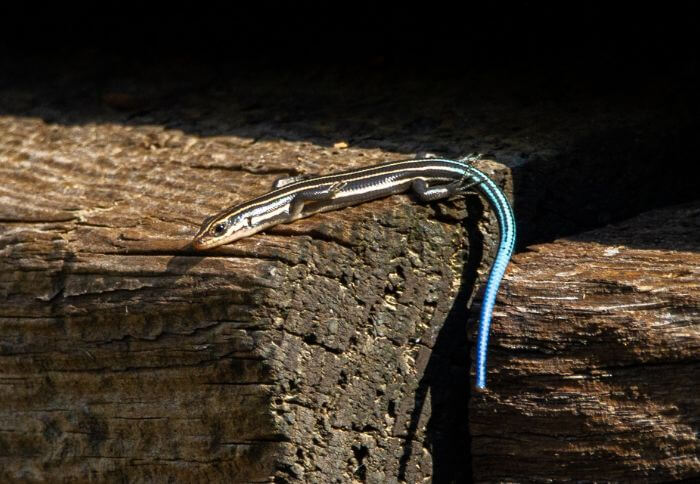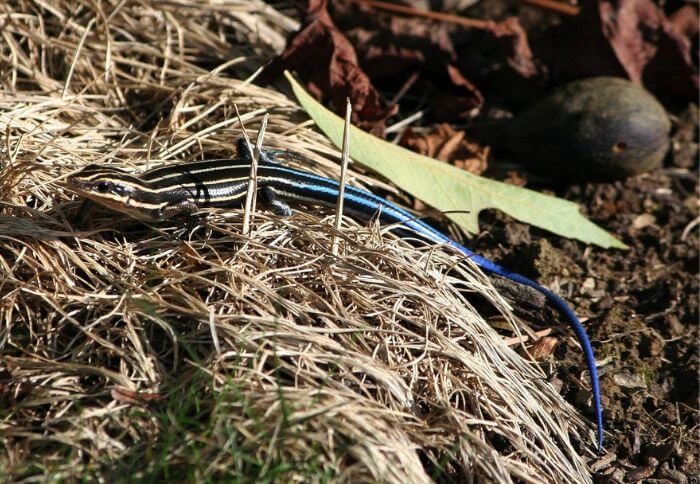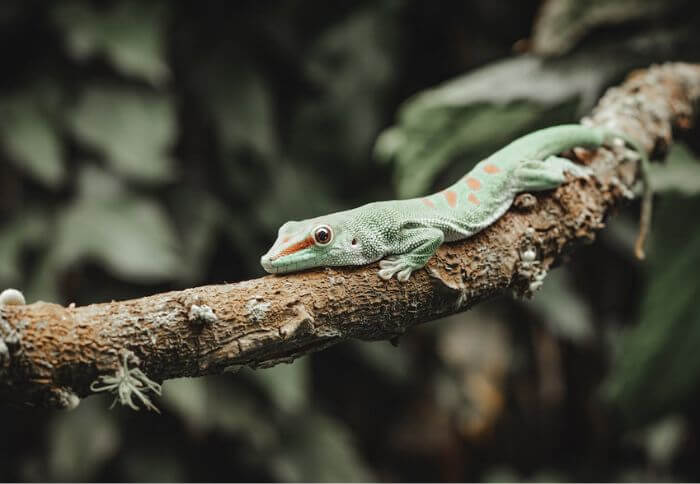Black Lizards with Blue Tails (5 Stunning Species)
When it comes to these enigmatic creatures, there’s more than meets the eye. Throughout history and across different cultures, these lizards have been revered as symbols of resilience, adaptability, and even mystical powers.
Whether you’re an avid reptile enthusiast or simply curious about the natural world, delving into the various types of black lizards with blue tails will open up a whole new realm of discovery and appreciation for these remarkable animals.
List of black lizards with blue tails
1. Blue-tailed Skinks

Blue-tailed skinks, also known as the five-lined skink, are captivating creatures that grace forests and woodlands with their vibrant blue tails.
This elusive lizard species is known for its impressive ability to lose its tail when threatened by predators, a process known as autotomy. However, what makes these skinks truly fascinating is their remarkable ability to regenerate their lost tails over time.
In addition to their stunning blue tails and regenerative prowess, blue-tailed skinks are agile hunters, feeding on various insects, spiders, and even smaller lizards.
Their sleek bodies and swift movements make them adept at capturing prey in their natural habitat. Moreover, these skinks have intricate social behaviors within their own species which involve complex communication signals and territorial displays.
2, Great Plain Skinks
The Great Plain Skink, also known by its scientific name Plestiodon obsoletus, is a striking black lizard with a distinctive blue tail that catches the eye of anyone lucky enough to spot one in its natural habitat.
These sleek creatures are adept at blending into their surroundings, using their coloration and stealthy movements to avoid predators and hunt for their preferred diet of insects, spiders, and small invertebrates.
Found predominantly in the grasslands and savannas of central North America, these skinks thrive in open habitats with plenty of sunlight and loose soil for burrowing.
Interestingly, despite their vibrant appearance and elusive nature, Great Plain Skinks often go unnoticed due to their shy behavior and preference for underground living.
However, those who take the time to observe them will be rewarded with glimpses of intricate social behaviors among these fascinating reptiles.
From complex communication signals using body language to territorial disputes over prime basking spots in the sun-drenched plains, there is much more to the life of a Great Plain Skink than meets the eye.
3. Orange-throated Whiptail
The vibrant and elusive Orange-throated whiptail, also known as the plateau striped whiptail, is a striking lizard species found in the southwestern United States and northwestern Mexico.
With its sleek body and distinctive orange throat, this creature is a sight to behold in its natural habitat. The Orange-throated whiptail’s unique coloration serves as a form of communication, signaling dominance or submission within their social groups.
This fascinating aspect of their behavior adds an intriguing layer to their already captivating appearance.
Unlike other species of lizards, the Orange-throated whiptail has evolved to reproduce through parthenogenesis, a process that allows females to produce offspring without mating with males.
4. Western Skink

The Western skink, also known as the blue-tailed skink, is a fascinating reptile found in the western United States. What sets this creature apart is its striking appearance – with a sleek black body and a vibrant, iridescent blue tail.
This unique coloration serves as a defense mechanism, distracting predators while the skink makes its escape. However, the beauty of the blue tail goes beyond mere aesthetics; it’s an example of evolutionary adaptation at its finest.
Despite its small size, the Western skink plays an important role in its ecosystem as both predator and prey. Its diet consists of insects and other small invertebrates, making it a valuable controller of pest populations.
But at the same time, it falls victim to larger predators such as birds and snakes. This delicate balance highlights the interconnectedness of all living creatures within their environment, showcasing how even a seemingly inconspicuous reptile like the Western skink contributes to the intricate web of life in nature.
5. Southeastern Five-lined Skink
The Southeastern five-lined skink, a stunning reptile with its sleek black body and vibrant blue tail, is a sight to behold in the southeastern United States.
As one of the most common lizards in the region, this small creature captivates with its agility and vibrant coloring.
What’s particularly fascinating about the Southeastern five-lined skink is its ability to lose and regenerate its tail as a defense mechanism against predators—a natural wonder that showcases the lizard’s resilience and adaptability.
Beyond its striking appearance, this little reptile plays an essential role in maintaining ecological balance within its habitat. Its diet primarily consists of insects, making it an efficient predator that helps control insect populations in its ecosystem.
While often overlooked due to their size, these lizards are integral to the delicate web of life in their environment. Studying their behavior and interactions with other species can offer valuable insights into broader ecological processes, highlighting the interconnectedness of all living beings within a given ecosystem.
6. Desert Grassland Whiptail Lizard
The desert grassland whiptail lizard, also known as the black lizard with a blue tail, is a fascinating creature that thrives in the arid landscapes of the American Southwest.
Its sleek black body and striking blue tail make it one of the most visually stunning lizards in its habitat, capturing the attention of wildlife enthusiasts and researchers alike.
Despite its small size, this lizard is a resilient and resourceful survivor, adapting to the harsh conditions of its environment with stealth and agility.
One particularly intriguing aspect of the desert grassland whiptail lizard is its reproductive strategy. Unlike most reptiles, this species consists entirely of females who engage in a form of pseudo-copulation to stimulate egg production.
This unique reproductive behavior sheds light on the incredible diversity of strategies that evolution has produced in response to environmental challenges.
It serves as a reminder that nature continually surprises us with its ingenuity, pushing us to expand our understanding and appreciation for even the smallest inhabitants of our planet.
Are blue-tailed lizards poisonous?
Blue-tailed lizards, often known as skinks, are not inherently poisonous creatures. While the vibrant blue coloring on their tails might suggest a warning signal commonly associated with poisonous animals, skinks actually use this unique feature for defense and communication.
When threatened, they can detach their tails as a distraction mechanism to escape from predators.
This act, known as autotomy, allows the lizard to survive while its tail continues to wriggle and attract the attention of the predator – a fascinating evolutionary adaptation that sets them apart from truly venomous creatures.
It’s important to note that while blue-tailed lizards are not poisonous, they should still be admired from a respectful distance in their natural habitats. Their role in maintaining ecological balance cannot be overstated, as they contribute to pest control by preying on insects and other small organisms. By understanding and appreciating these captivating creatures without fearing their non-existent toxicity, we can foster a greater sense of coexistence with the diverse wildlife around us.
What does it mean if a lizard has a blue tail?
The sight of a black lizard with a blue tail is truly a spectacular one, and many people find themselves wondering about the significance of such an unusual trait. In many lizard species, a vibrant blue coloration in the tail can serve as a form of defense mechanism. When threatened or pursued by predators, lizards may intentionally detach their tails as a distraction, allowing them to swiftly escape while the predator is left bewildered by the wriggling blue appendage.
Interestingly, the bright blue coloration can also signal various messages within lizard communities.
It may represent dominance or status in territorial disputes or courtship rituals. Furthermore, some experts suggest that certain toxins present in the tail could contribute to its distinctive hue—serving as both a warning sign and an effective defense tool against potential threats.
Regardless of the exact reason behind it, one thing is clear: encountering a black lizard with a brilliantly blue tail offers us a fascinating glimpse into nature’s remarkable strategies for survival and communication.
Where can you find western skinks
One of the best places to find western skinks is in the arid and semi-arid regions of North America.
These elusive lizards are often spotted in rocky and sandy areas such as deserts, grasslands, and scrubland. Look out for them basking on rocks or scurrying through the underbrush, as they are known for their quick movements and ability to blend into their surroundings with their brownish-grey coloration.
Western skinks can also be found near water sources such as streams, rivers, and marshes, where they hunt for insects and small invertebrates.
Their preference for sun-soaked habitats makes them particularly prominent in warm climates, so keep an eye out for these fascinating reptiles when exploring the diverse landscapes of the western United States.
Whether you’re hiking through a canyon or strolling along a riverbank, you may just catch a glimpse of these sleek lizards darting across the terrain.
Related Read: Rainforest lizards
What do blue skinks eat?
Blue skinks, with their vibrant blue tails and sleek black bodies, are fascinating creatures that capture the imagination of anyone who encounters them.
These reptiles have a varied diet that includes insects, spiders, small invertebrates, and even some plant matter. Their opportunistic feeding habits allow them to thrive in diverse habitats, from forests to urban environments.
In the wild, blue skinks actively forage for their food, using their keen sense of smell and sight to locate prey. They are adept hunters and will eagerly consume crickets, grasshoppers, beetles, and other small insects they come across.
Additionally, these adaptable lizards may also nibble on fruits or vegetation available in their environment as a supplement to their primarily carnivorous diet.
Despite being skilled predators in their own right, blue skinks have also been known to scavenge for food when opportunities arise.
This behavior gives them an edge in survival by allowing them to exploit a wide range of resources within their ecosystem. Overall, the dietary preferences of these captivating reptiles contribute to their success as resilient and adaptable inhabitants of various landscapes.
Final Thoughts:
Black lizards with blue tails are a fascinating and diverse group of reptiles that inhabit various ecosystems around the world. Their unique coloration and behaviors make them a subject of interest for researchers and wildlife enthusiasts alike.
From the agile anoles to the striking skinks, these lizards play crucial roles in their respective environments, contributing to biodiversity and ecosystem health.
As we continue to study and appreciate these creatures, it’s essential to prioritize conservation efforts to ensure their survival amidst changing environmental conditions.
By learning more about black lizards with blue tails and supporting conservation initiatives, we can help protect these remarkable animals for future generations to enjoy and admire. Let’s work together to safeguard their habitats and ensure their continued existence in the wild.
source:

Passionate animal enthusiast and skilled writer with a flair for captivating storytelling. With over five years of experience, I have crafted engaging content that sheds light on the fascinating world of animals.
Through my articles, blog posts, and social media campaigns, I strive to raise awareness about conservation efforts and promote a deeper understanding of the natural world.


